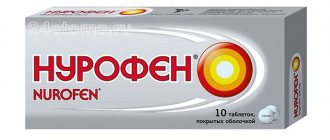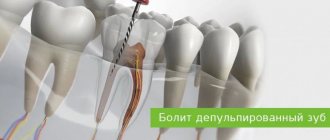Clinic “No Hurt!”
Enlarge
A patient comes to the doctor with caries. Or, during an examination, the doctor discovers caries. Treatment is prescribed. Dental tissue damaged by infection is removed and the tooth geometry is restored using a filling. The nerve of the tooth is not affected during caries treatment and the tooth remains alive. The patient goes home, but the tooth does not allow itself to be forgotten. It hurts to bite. It hurts to chew. Pain occurs when biting, pressing, or pressing on a tooth.
We addressed this topic in the article Tooth hurts after filling. In this publication we will reveal the causes of toothache under a filling after caries treatment.
Causes of pain
After pulpitis, a tooth hurts for several reasons - damage to the tissues surrounding the tooth root (periodontal) or an inflammatory process.
Tissue damage can be caused by the following circumstances:
- formation of a wound surface during removal of the neurovascular bundle of a tooth;
- treatment of root canals with antiseptic agents if the antiseptic leaves the canal.
Can a tooth hurt after pulpitis due to the dentist’s dishonest work? The inflammatory process can occur due to poor quality work by the doctor. Signs of poor treatment of pulpitis on an x-ray are:
- incomplete filling of root canals, when there is still free space left to the apex;
- excessive filling of root canals, when the filling material extends beyond the apex of the root canal;
- extra holes in the root canals.
Why does a tooth hurt after caries treatment?
The pain reaction depends not only on the professionalism of the doctor, but also on the individual characteristics of the human body, its pain sensitivity threshold.
Caries is the most common disease for which people consult a dentist.
It happens that after treatment, pain may occur when biting, tooth sensitivity, and soreness of the gums may appear.
What could cause this?
- If the treatment was using local anesthesia, which was carried out directly near the tooth, then naturally the gums may react, because Anesthesia is an injection, therefore there is a small wound that heals over a certain period of time. (prick your finger, it will also hurt for a while).
- When treating superficial and medium-sized caries, sometimes there is increased sensitivity of the enamel, which is manifested by sharp tingling sensations in the tooth. Such sensations usually occur after exposure to a certain irritant (cold, hot, sour, sweet). The fact is that in the process of treating caries and further placement of fillings, they are made as follows called etching of the enamel with a special agent, which is then washed off and the surface is dried. If the dentin is dried too much, the dentinal tubes of which it consists lose internal moisture, which leads to pain. Usually these phenomena disappear within 1-2 weeks. During this time, the overdried tissues are filled with moisture again and the sensitivity goes away. If symptoms continue, you should contact your dentist.
- Pain can also occur due to under-drying of the tooth. In this case, the tooth reacts when you press and bite on it. And the point is this: after etching the enamel, a special adhesive is used to ensure good fixation of the filling, which penetrates into the dentinal tubules. After which the filling material is applied, which is then illuminated with a lamp. And in a place where there was excess moisture and an uneven adhesive layer was created, the seal comes off. And during the chewing process, i.e. When pressing on a tooth, pain appears.
- If your tooth hurts after treatment of deep caries, do not worry. This is a normal tooth reaction. It should be remembered that in this case the pain can last up to several days. It gradually decreases and then goes away completely. This is due to the fact that the carious cavity comes very close to the dental pulp (neurovascular bundle) and all manipulations during tooth treatment in this case have an irritating effect. Over time, the pulp builds a “roof” over itself from new dentin - it hides, and the painful sensations gradually stop. But if the tooth still hurts even after 2 weeks, you need to consult a dentist. Perhaps complicated caries – pulpitis (nerve inflammation) – is already taking place here.
When there is no need to see a doctor
Why does a tooth hurt after pulpitis? The appearance of pain is due to the increased trauma of the entire procedure, which consists of opening the tooth, removing pulp from the root canal and filling the empty space with artificial material - a filling.
How long does a tooth hurt after pulpitis in normal condition? Without pathologies, the pain persists for 5-10 days, and it gradually subsides. It is considered normal when:
- after pulpitis, the tooth hurts without increasing pain;
- there is no bleeding, swelling, swelling or redness, general weakness, or fever.
Depulpation as a cause of tooth pain
The term “depulpation” refers to the removal of the pulp – the nerve. The pulp consists of nerve fibers and vascular tissue. Thanks to it, the tooth receives adequate nutrition and is endowed with sensitivity. When the pulp is removed, the tooth becomes dead and, logically, should not hurt, but sometimes the opposite happens.
A tooth with removed pulp may respond to pressure with pain for various reasons, and more often this is a medical error:
- root puncture during canal cleaning;
- a thin fragment of an endoscope remained inside the canal;
- the channel was not completely cleaned.
In the latter case, pain occurs some time after the procedure. In the first two options, pain appears immediately and occurs with a light touch. Each of these situations requires an immediate visit to the doctor.
Potential Causes of Pain
In most clinical cases, the cause of pain and discomfort is medical error and non-compliance with treatment technology.
Possible reasons:
- Errors during the preparation of a carious area: overheating of the dentin, perforation of the bottom or wall of the carious cavity, breaking off the wall of the carious cavity, damage to neighboring teeth by the bur or damage to the gum edge on the neck of the tooth. What method can be used to correct the situation depends on the type of error made. As a rule, the tooth is re-treated and filled again.
- Violation of filling technology by a specialist.
- Incomplete grinding of the filling. In this case, the installed filling rises slightly above the walls of the tooth; when the jaws are closed and chewed, another tooth puts pressure on it. As a result, the filling puts pressure on the pulp, causing irritation of the nerve endings and pain. The pain can only be eliminated by additional grinding of the filling to the required size.
- Overdrying of the carious cavity. Before filling, the tooth walls are thoroughly dried with a stream of warm air. This is necessary so that the filling material is well secured and subsequently the filling does not fall out of the tooth. Excessive drying sometimes damages the nerve endings located in the surface layer of dentin. This causes pain and is fraught with the development of inflammation of the dental nerve. The correction method is removal of the filling, removal of the nerve and filling of the root canals, installation of a new filling.
- Insufficient drying of the carious cavity. In the presence of moisture, the filling is not firmly fixed to the walls of the tooth. As the filling material dries, it decreases in volume and the filling literally “lags behind” the walls. As a result, voids form between it and the walls of the tooth and irritation of the nerve endings occurs. After a short time, the filling usually falls out. The situation can be corrected with a new filling.
- Allergy to components in the filling - in this case, only new treatment using other materials will help. In addition to pain, allergies are accompanied by a rash, redness of the skin, swelling, and the gums at the treatment site may swell.
- Tissue infection followed by inflammation. During treatment, an infection enters the tooth cavity and provokes inflammation of the nerve endings. This process is called pulpitis. Its characteristic feature is severe acute pain, which occurs for no apparent reason and intensifies at night. In an advanced stage, pulpitis turns into periodontitis and provokes the formation of a cyst. Therefore, if acute, persistent pain appears, you should consult a doctor as soon as possible.
In most cases, a specialist’s mistake can be corrected without serious complications or consequences for the patient. The earlier the pathology is identified, the higher the likelihood of its successful elimination.
Pain after caries treatment is a fairly common phenomenon, and this is its insidiousness. Often, patients cannot recognize the presence of complications in time and turn to a specialist only when the complication reaches the acute stage and provokes concomitant diseases. Therefore, if pain occurs, it is better to consult a specialist once again than to endure and wait.
Caries
If after treatment the tooth hurts when pressing or eating, this is considered normal and can persist for up to two months. This is explained by the fact that with deep caries, a very thin layer of dentin remains between the pulp and the filling, so when pressing or biting, pressure is transferred to the nervous tissue and causes pain.
In addition, the patient may experience dull pain for 14 days. This is also considered normal and is explained by a reaction to the use of boron, as well as various medications. But, if even after two weeks the discomfort does not go away, you need to contact your dentist.
Acute or throbbing pain is a reason to visit the dentist immediately: perhaps a carious infection has penetrated into the pulp, causing pulpitis. The sooner you do this, the higher the chance of avoiding the removal procedure and the subsequent need for prosthetics. You can learn how to avoid caries from the article “Prevention of caries.”
How to relieve pain
Even mild pain can cause many problems. They are distracting and annoying, so it’s only logical to take steps to eliminate them.
Important: we are talking about pain, which is a consequence of the treatment of deep caries and is not a symptom of complications. You can reduce it and at the same time speed up the tissue healing process in the following ways:
- taking painkillers;
- rinsing the mouth with a soda-saline solution;
- rinsing and bathing with a decoction of sage and chamomile;
- temporary removal of hot and cold foods from the diet;
- refusal of spicy, sour, and also too hard foods;
- avoiding too much stress on the tooth;
- quitting smoking and alcohol.
If the treatment procedure was carried out correctly, the pain will begin to subside on the third day and completely disappear on the fifth day.
What can hurt a tooth?
A tooth consists of a root and a crown. It is covered as a frame with dentin and cement in the root area, dentin and enamel in the crown area. These are hard tissues that lack nerve endings, so they cannot hurt. Inside the tooth there is a space filled with tissue penetrated by branches of nerves. This is pulp. The pulp is also contained in the canals that connect the tooth cavity to the root. Any diseases (for example, inflammation - pulpitis) and injuries to the pulp are very painful.
Periodontitis is also a very painful disease - inflammation of the periodontium - the ligament that holds the root in the socket, since there are also many branches of nerves in the periodontium.
Relief from pain
If this symptom bothers you greatly or is accompanied by edema or swelling, then contact your dentist. Experienced doctors at the Aurora Star clinic will quickly identify the cause of pain and make every effort to eliminate it. Sometimes this requires simply filling the tooth again (for example, if it was underfilled or overfilled). If complications occur, such as periodontitis, then surgical treatment will be required - an incision to remove pus.
Sometimes pain is a natural phenomenon after treatment for dental diseases. But everyone has their own pain threshold. If this symptom bothers you greatly, your doctor will help you choose the appropriate painkillers. At the Aurora Star clinic you can get rid of the consequences of poor-quality dental treatment, and at the same time, pain. Experienced dentists, modern equipment and a pleasant pricing policy await you.
Periodontitis
A slight aching pain or pain when pressing on a tooth, which occurs after the end of the periodontitis treatment procedure, is considered normal and goes away on its own over time. If your gums or cheeks are swollen, you have paroxysmal pain, or your body temperature has risen, you should go to the hospital as soon as possible.
In our dental center in Brest you will receive qualified dental care both for caries, pulpitis and periodontitis, and for pain after dental intervention.










